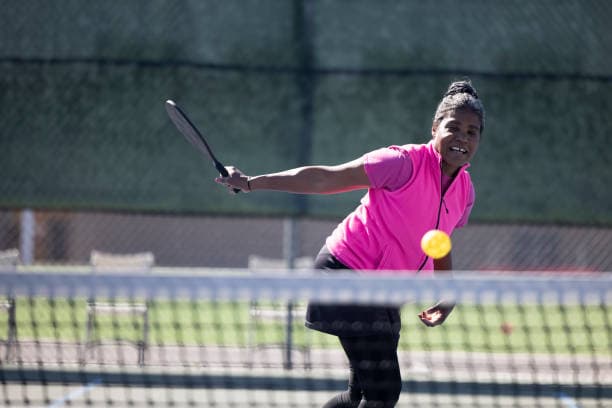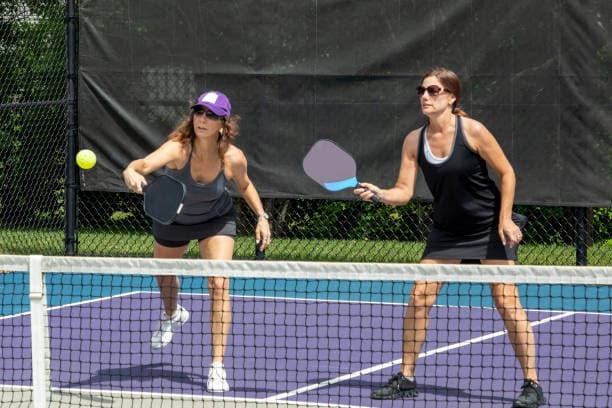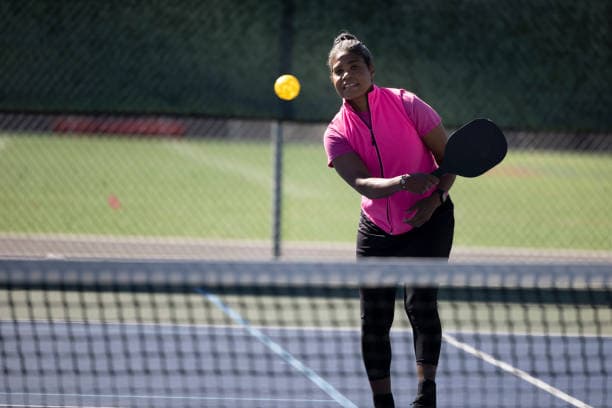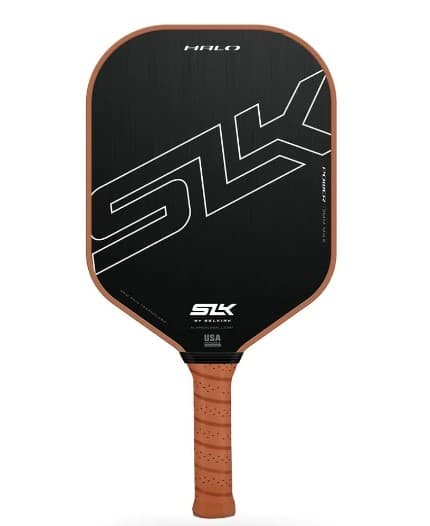The objective of pickleball is to outmaneuver opponents by placing shots strategically and reacting quickly in order to score points. In this article, we will delve into one crucial aspect of pickleball: transitioning from defense to offense.
Importance of Transitioning from Defense into Offense Playing Pickleball
Transitioning from defense to offense is crucial in pickleball as it allows you to take control of the game and put pressure on your opponents. While defense plays an important role in keeping rallies alive and preventing opponents from scoring points easily, staying solely on the defensive can be limiting when it comes to winning matches consistently. By mastering the art of turning defense into offense, you’ll become proactive rather than reactive – seizing opportunities presented by opponents’ weaker shots or positioning and launch powerful attacks.
Transitioning quickly and effectively can catch opponents off guard, forcing them into a defensive stance and giving you the upper hand to dictate the flow of the game. In essence, mastering this transition is a key component of becoming a well-rounded pickleball player capable of dominating matches.
Understanding the Basics
The Roles of Each Player
In pickleball, there are three primary roles that players assume during a match: server, receiver, and partner in doubles. The partner’s role is crucial in strategic gameplay as they provide support for their teammate by covering specific areas on the court while also being ready to respond to opponents’ shots effectively. Communication between partners becomes vital for successful coordination during both defensive and offensive plays.
Importance of Effective Shot Placement and Strategy
Shot placement in pickleball is a critical aspect that can turn defense into offense if executed skillfully. The ability to hit shots accurately in specific zones across your opponent’s side of the court can disrupt their positioning and force them into defensive situations. Strategic shot placement involves recognizing weaknesses in your opponents’ positioning, exploiting open spaces on the court, and understanding the strengths and limitations of your own skills.
By strategically placing shots away from opponents’ reach or exploiting their vulnerabilities, you can create opportunities to transition from defense to offense. Furthermore, a well-thought-out strategy helps you maintain control of the rally and keeps your opponents off balance.
Remember, pickleball is not solely a game of power; it requires finesse, precision, and strategic thinking. Developing a deep understanding of shot placement and strategy will significantly enhance your ability to transform defensive situations into offensive opportunities.
Mastering Defensive Techniques
Proper Positioning on the Court for Defensive Play
Finding the ideal position on the pickleball court is crucial to effectively transition from defense to offense. When playing defensively, it is essential to stay close to the baseline to cover as much ground as possible.
By positioning yourself near the back line you create a solid foundation that enables you to react quickly and reach shots that are hit deep into your side of the court. This strategic placement ensures that you have ample time and space to return difficult shots and maintain control over rallies.
Anticipating Opponent's Shots
Becoming a truly formidable defender in pickleball requires developing keen observation skills and attentiveness towards your opponents’ body language and paddle position. By carefully studying their movements you can anticipate where they might direct their shots.
Pay attention to their posture, footwork, and racket preparation as they position themselves to strike. These subtle cues can provide valuable insights into their intentions that allow you to predict the trajectory of their shot early on.
Maintaining a Balanced Stance
Maintaining a balanced stance is pivotal when playing defensive pickleball. It allows for swift lateral movements across the court so that you can efficiently react to your opponent’s shots.
Keep your weight centered between both feet throughout each rally, distributing it evenly so that you can easily pivot in any direction required. By remaining balanced you’ll be able to swiftly change directions without sacrificing stability or control over your movement.
Developing Strong Defensive Shots
The Dink Shot
The dink shot is an essential defensive technique used in pickleball which involves delicately striking the ball with finesse and precision, aiming to drop it just over the net into the non-volley zone. This shot creates minimal bounce and forces your opponents into a defensive position near the net that restricts their ability to strike powerful shots.
The dink shot is executed by gently brushing under the ball with a soft touch, maintaining control and placement rather than relying on force. Mastery of this shot allows you to gain an advantageous offensive position and apply pressure on your opponents.
The Lob Shot
In certain defensive situations using a lob shot can prove highly effective in regaining control of the rally. The lob involves striking the ball high into the air in a gentle arc, ensuring it sails over your opponents’ heads towards the back of their court as deep inside the baseline as possible.
The lob buys you time to reposition yourself while forcing your opponents to retreat towards the baseline, resetting the rally dynamics in your favor. Accurate execution is key as you want to avoid hitting it too short or too long; instead, aim for a height that allows sufficient time for recovery.
The Block
When faced with powerful shots from your opponent, hitting a well-executed block can be instrumental in turning defense into offense. The block involves compact swing mechanics that allow you to redirect incoming shots rapidly without generating excessive power or relying solely on a full stroke.
This controlled response effectively halts momentum while directing the ball back toward your opponent’s side with accuracy and precision. You are essentially using your opponent’s power against him or her. By executing timely blocks you not only neutralize aggressive attacks but also set up opportunities for counterattacks and offensive maneuvers.
Turning Defense into Offense
Recognizing Opportunities for Counterattacks
In the fast-paced game of pickleball, the ability to quickly shift from defense to offense is crucial. One key skill is identifying moments when your opponents are on the defensive or in compromising positions. This can occur when they struggle to recover after a difficult shot, when their positioning is off, when they are caught out of balance or when they unintentionally hit a high short ball that can be attacked.
These fleeting moments present golden opportunities for you to seize control and turn the tide in your favor.
Identifying Weak or Vulnerable Positions on Your Opponent
To effectively turn defense into offense, it’s essential to analyze your opponents’ court positioning and identify areas where they may be weaker or more vulnerable.
Look for gaps left open between them, anticipate shots that force them away from their optimal position, and exploit any weaknesses in their shot selection or movement. By studying your opponents’ patterns and tendencies you can strategically target these vulnerable spots on their side of the court.
Noticing When Your Opponent is Out of Position
A keen observation will greatly enhance your ability to convert defense into offense in pickleball. Always stay alert and watchful for signs that opponents may be out of position or off-balance during rallies.
This could manifest as exaggerated foot movements, reaching awkwardly for shots, or failing to recover quickly after a difficult return. By capitalizing on these moments of imbalance with accurate placement and powerful shots, you can disrupt your opponents’ rhythm and launch an effective offensive attack.
See the High Short Ball
Seeing and reacting are two different things in pickleball and knowing when and how to react can change the entire dynamic of a point. For example, your opponent is controlling the point, pushing you from side to side and all of a sudden they hit a short high ball ready to be pounced on. Some players will just continue the rally and play out the point hoping the opponent makes an error. An offensive minded player will see this short high ball as red meat.
They will immediately switch gears, the anticipatory neurons in their brain firing off as they recognize the opportunity that’s just been served up to them. Their feet shuffle quickly, positioning themselves perfectly to intercept the high ball. Rather than waiting for it to drop, they will leap into action, their paddle already poised for a powerful overhead smash or at the least an approach shot. The offensive player has now taken control of the point and put their opponent on the defensive. You need to see the opportunities and seize them.
Strategies for Offensive Play
The Third Drop Shot
The third-shot drop is a critical offensive strategy to regain control of the game. After your serve, aim for a gentle shot that clears the net and lands softly just beyond the non-volley zone line on your opponents’ side.
This forces them back and provides you with an opportunity to move forward to take control of the court’s midpoint. The third-shot drop requires finesse, touch, and careful execution to put pressure on your opponents.
The Drive
Another effective offensive strategy is the drive, which involves hitting powerful shots that target your opponents’ feet or sidelines. By executing well-placed drives you force your opponents into reactive defensive positions and create openings in their defense.
Aim for shots that are difficult to return due to their speed, angle, or unexpected placement. The drive allows you to maintain control of the rally while keeping your opponents off balance.
Applying Pressure
Lastly, applying constant pressure is crucial in turning defense into offense. By maintaining a relentless attack and consistently forcing difficult returns from your opponents you’ll increase the likelihood of generating weak responses or unforced errors.
Apply pressure through a combination of shot variety, placement changes, and aggressive court positioning. This concerted effort will keep your opponents on their toes and enable you to seize any opportunities that arise during rallies.
Conclusion
Transforming defensive situations into offensive opportunities is a skillset that separates exceptional pickleball players from average ones. By recognizing counterattack possibilities players can effectively plan strategies for offensive play. This proactive approach applies continuous pressure on adversaries while maintaining control over rallies. As you embrace these techniques and develop the ability to seamlessly transition from defense to offense, your pickleball game will reach new heights.
Remember, every defensive situation is a chance for you to strategically seize control and create winning opportunities. With dedication and practice you can become a formidable force on the pickleball court.






